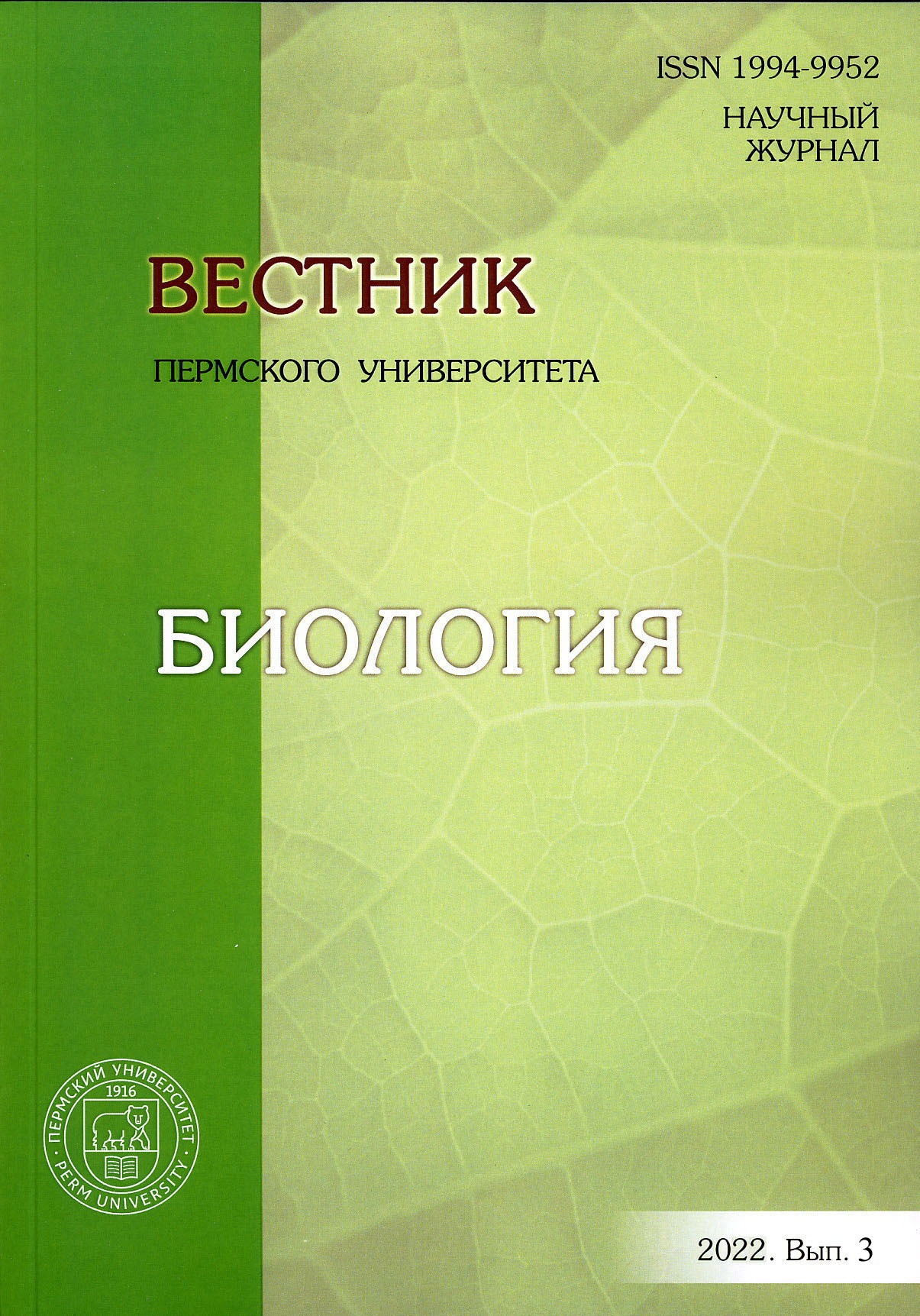Разложение хлорбензойных кислот штаммами Rhodococcus ruber P25 и Microbacterium oxydans B51 в условиях кометаболизма
##plugins.themes.bootstrap3.article.main##
Аннотация
##plugins.themes.bootstrap3.article.details##
Лицензионный договор на право использования научного произведения в научных журналах, учредителем которых является Пермский государственный национальный исследовательский университет
Текст Договора размещен на сайте Пермского государственного национального исследовательского университета http://www.psu.ru/, а также его можно получить по электронной почте в «Отделе научных периодических и продолжающихся изданий ПГНИУ»: YakshnaN@psu.ru или в редакциях научных журналов ПГНИУ.
Библиографические ссылки
Плотникова Е.Г. и др. Особенности разложение 4-хлорбифенила и 4-хлорбензойной кислоты штаммом Rhodococcus ruber Р25 // Микробиология. 2012. Т. 81, № 2. С. 159–170. DOI: 10.1134/S0026261712020117.
Рыбкина Д.О. и др. Новый аэробный грамположительный микроорганизм с уникальными свойствами деструкции орто- и пара-хлорированных бифенилов // Микробиология. 2003. Т. 72, № 6. C. 759–765.
Федоров Л.А. Диоксины как экологическая опасность: ретроспектива и перспективы. М.: Наука, 1993. 266 с.
Adebusoye S.A., Miletto M. Characterization of multiple chlorobenzoic acid-degrading organisms from pristine and contaminated system: mineralization of 2,4-dichlorobenzoic acid // Bioresource Technology. 2011. Vol. 102. P. 3041–3048. https://doi.org/10.1016/j.biortech.2010.10.026.
Agulló L. Genetics and biochemistry of biphenyl and PCB biodegradation // Rojo F. (ed.) Aerobic Utilization of Hydrocarbons, Oils, and Lipids. Handbook of Hydrocarbon and Lipid Microbiology. Springer, 2019. P. 595–622.
Chang Y.-C. et al. Isolation of biphenyl and polychlorinated biphenyl-degrading bacteria and their degra-dation pathway // Applied Biochemistry and Biotechnology. 2013. Vol. 170. P. 381–398. https://doi.org/10.1007/s12010-013-0191-5.
Cho Y. C. et al. Enhancement of microbial PCB dechlorination by chlorobenzoates, chlorophenols and chlorobenzenes // FEMS Microbiology Ecology. 2002. Vol. 42. P. 51‒58. https://doi.org/10.1111/j.1574-6941.2002.tb00994.x.
Denef V.J. Genetic and genomic insights into the role of benzoate-catabolic pathway redundancy in Burk-holderia xenovorans LB400 // Applied and Environmental Microbiology. 2006. Vol. 72. P. 585–595. https://doi.org/10.1128/AEM.72.1.585-595.2006.
Hernandez B.S. et al. Terpene-utilizing isolates and their relevance to enhanced biotransformation of po-lychlorinated biphenyls in soil // Biodegradation. 1997. Vol. 8. P. 153–158. https://doi.org/10.1023/A:1008255218432.
Hickey W.J. et al. Cloning, nucleotide sequencing, and functional analysis of a novel, mobile cluster of biodegradation genes from Pseudomonas aeruginosa strain JB2 // Applied and Environmental Microbiology. 2001. Vol. 67. P. 4603–4609. https://doi.org/10.1128/AEM.67.10.4603-4609.2001.
Ilori M.O. et al. Aerobic mineralization of 4,4’-dichlorobiphqnyl and 4 chlorobenzoic acid by a novel natural bacterial strain that grows poorly on benzoate and biphenyl // World Journal of Microbiology and Biotechnology. 2008. Vol. 24. P. 1259–1265. https://doi.org/10.1007s11274-007-9597-y.
Jia Y. et al. Identification and characterization of a meta-cleavage product hydrolase involved in bi-phenyl degradation from Arthrobacter sp. YC-RL1 // Applied Microbiol Biotechnology. 2019. Vol. 103, № 16. P. 6825–6836. https://doi.org/10.1007/s00253-019-09956-z.
Kolar A.B. et al. PCB-degrading potential of aerobic bacteria enriched from marine sediments // International Biodeterioration and Biodegradation. 2007. Vol. 60. P. 16–24. https://doi.org/10.16/j.ibiod.2006.11.004.
Parales R.E., Resnick S.M. Aromatic Ring Hydroxylating Dioxygenases // Ramos JL., Levesque R.C. (Eds) Pseudomonas. Boston: Springer, 2006. P. 287–340. https://doi.org/10.1007/0-387-28881-3_9.
Providenti M.A., Wyndham R.C. Identification and functional characterization of CbaR, a MarR-like modulator of the cbaABC-encoded chlorobenzoate catabolism pathway // Applied and Environmental Microbiology. 2001. Vol. 67. P. 3530–3541. https://doi.org/ 10.1128/AEM.67.8.3530-3541.2001.
Radice F. et al. Cloning of the Arthrobacter sp. FG1 dehalogenase genes and construction of hybrid pathways in Pseudomonas putida strains // Applied Microbiology and Biotechnology. 2007. Vol. 75. P. 1111–1118. https://doi.org/10.1007/s00253-007-0906-z.
Shumkova E.S. et al. Draft genome sequence of Rhodococcus ruber strain P25, an active polychlorinated biphenyl degrader // Genome Announcements. 2015. Vol. 3. Article e00990-15. https://doi.org/10.1128/genomeA.00990-15.
Solyanikova I.P. et al. Peculiarities of the degradation of benzoate and its chloro- and hydroxy-substituted analogs by actinobacteria // International Biodeterioration & Biodegradation. 2015. Vol. 100. P. 155–164. https://doi.org/10.1016/j.ibiod.2015.02.028.
Stratford J. et al. Influence of chlorobenzoates on the utilisation of chlorobiphenyls and chlorobenzoate mixtures by chlorobiphenyl/chlorobenzoate-mineralising hybrid bacterial strains // Archives of Microbiology. 1996. Vol. 165. P. 213–218. https://doi.org/10.1007/BF01692864.
Tsoi T.V. et al. Cloning and expression of the Arthrobacter globiformis KZT1 fcbA gene encoding dehalogenase (4-chlorobenzoate-4-hydroxylase) in Escherichia coli // FEMS Microbiology Letters. 1991. Vol. 81. P. 165–170. https://doi.org/10.1016/0378-1097(91)90298-o.
Xu C. et al. Degradation of three monochlorobenzoate isomers by different bacteria isolated from a con-taminated soil // International Biodeterioration & Biodegradation. 2017. Vol. 120. P. 192–202. https://doi.org/10.1016/j.ibiod.2017.02.020.
Yasir M.W. et al. Biotreatment potential of co-contaminants hexavalent chromium and polychlorinated biphenyls in industrial wastewater: individual and simultaneous prospects // Science of the Total Environment. 2021. Vol. 779. Article 146345. https://doi.org/10.1016
/j.scitotenv.2021.146345.




